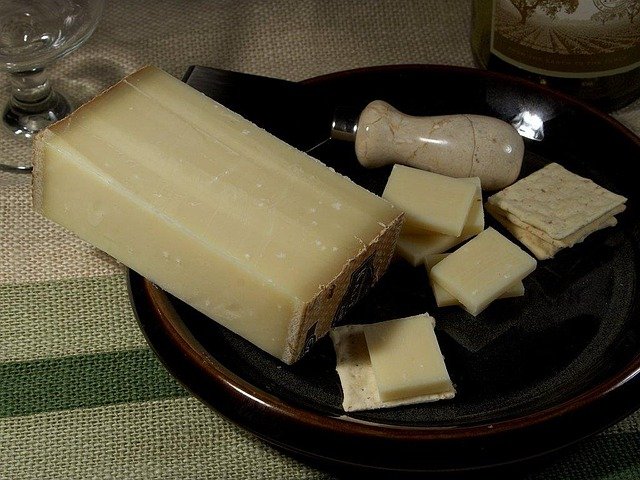Imagine savoring a cheese that offers a rich, nutty flavor with a hint of sweetness, leaving your taste buds craving more. That’s Gruyere for you—a Swiss treasure that’s not just cheese; it’s an experience.
As you delve into the world of Gruyere, you’ll discover why this cheese has captured the hearts (and taste buds) of gourmets worldwide. Are you ready to transform your cooking and elevate your cheese platters to new heights? Whether you’re a seasoned foodie or simply curious about what makes Gruyere so special, this cheese has something to offer you.
From its unique aging process to its versatility in both traditional and modern dishes, Gruyere is a culinary gem waiting to be explored. Keep reading to uncover the secrets of Gruyere and learn how you can use it to create unforgettable dining experiences.
History Of Gruyère
Gruyère is a popular cheese known for its rich, nutty flavor. Originating from Switzerland, it has been a favorite for centuries. This cheese is versatile and used in many dishes, from fondue to sandwiches. Its unique taste and texture make it a staple in kitchens worldwide.
Origin And Tradition
Gruyère cheese comes from the Gruyère region in Switzerland. Cheese-making in this area dates back to the 12th century. Swiss farmers perfected the process over generations. They use traditional methods to maintain its unique flavor. It is made from cow’s milk and aged for several months.
The production of Gruyère involves several steps. First, fresh cow’s milk is collected. It is then heated and mixed with rennet. This causes the milk to curdle. The curds are cut and heated again. Afterward, they are pressed into molds. The cheese is aged in cellars for 6 to 12 months.
Aging gives Gruyère its distinctive taste and texture. The longer it ages, the more intense the flavor becomes. During aging, it develops a brown rind. This rind is often removed before eating.
Uses In Cooking
It is versatile in the kitchen. It melts well, making it perfect for fondues and gratins. Its nutty taste enhances sandwiches and salads. It can be grated or sliced for different recipes.
Many chefs prefer Gruyère for its flavor and texture. It pairs well with fruits, nuts, and wines. Its versatility makes it a favorite in culinary arts.
Global Popularity
Gruyère’s fame has spread beyond Switzerland. It is now enjoyed worldwide. Many countries produce their versions of this cheese. However, the authentic Gruyère comes from Switzerland.
Its global demand continues to grow. People love its taste and quality. It remains a popular choice for cheese lovers everywhere.
Production Process
Gruyere is a delicious Swiss cheese. It is known for its rich flavor and smooth texture. Making Gruyere is an art. It involves a careful and detailed production process. This process ensures the cheese’s quality and taste. From milk sourcing to aging techniques, every step is crucial. It is fascinating to learn how each phase contributes to the final product.
Milk Sourcing
Milk sourcing is the first step in Gruyere production. The cheese is made from cow’s milk. This milk must be fresh and high-quality. Farmers often select cows that graze on lush pastures. This affects the milk’s flavor and richness. The milk is collected twice a day. It is important to maintain strict hygiene standards during collection. This ensures the milk is pure and uncontaminated.
Key points in milk sourcing include:
- Fresh milk: Essential for quality cheese.
- Pasture grazing: Enhances flavor.
- Hygiene standards: Prevents contamination.
Once collected, the milk is transported to the cheese factory. It must be processed quickly. This preserves its freshness and prevents spoilage. The milk is then ready for the next stage in cheese making.
Cheese Making Steps

Cheese making begins with heating the milk. This is done to kill bacteria. The milk is heated to a specific temperature. Then, rennet is added. Rennet helps the milk to coagulate. It forms curds and whey. The curds are cut and stirred. This separates them from the whey.
After stirring, the curds are drained. They are placed into molds. These molds shape the cheese. The cheese is then pressed. This removes excess whey. Pressing is important for the cheese’s texture. The cheese is left to rest for several hours. This allows it to firm up.
Key steps in cheese making include:
- Heating the milk: Ensures safety.
- Adding rennet: Forms curds.
- Curd cutting and stirring: Separates whey.
- Pressing: Shapes and firms the cheese.
Aging Techniques
Aging is the final phase in Gruyere production. It greatly influences the cheese’s taste and texture. Gruyere is typically aged for several months. During aging, the cheese is stored in a controlled environment. This environment has specific temperature and humidity levels. These conditions allow the cheese to develop its distinctive flavor.
The cheese is regularly turned during aging. This ensures even maturation. It is also brushed with brine. Brine helps protect the cheese and enhances its taste. As the cheese ages, it becomes more complex. Its flavors deepen and its texture becomes smoother.
Important aspects of aging include:
- Controlled environment: Optimal conditions for aging.
- Regular turning: Even maturation.
- Brine brushing: Flavor enhancement.
The aging process is crucial. It is what gives Gruyere its unique characteristics. The patience and care during aging ensure that Gruyere remains a beloved cheese worldwide.
Flavor Profile
Gruyere is a famous Swiss cheese known for its rich and complex flavor. It’s a versatile cheese, perfect for cooking and enjoying on its own. Gruyere has a unique taste that stands out among other cheeses. Its flavor profile combines sweet and salty notes, making it popular worldwide. Understanding Gruyere’s flavor can enhance your culinary experience.
Tasting Notes
Gruyere offers a wide range of flavors that delight the palate. At first bite, you notice sweet and nutty tones. These are often accompanied by earthy undertones. The cheese is aged, so it develops more flavor over time. Longer aging results in deeper and more intense flavors. You might detect hints of caramel and brown butter. These notes make Gruyere unique compared to other cheeses.
Here’s a breakdown of its tasting profile:
- Sweetness: Subtle and pleasing.
- Nuttiness: Rich and inviting.
- Earthy undertones: Adds depth.
- Caramel hints: Gives warmth.
- Brown butter notes: Enhances complexity.
Each bite offers a balanced mix of these flavors. Gruyere pairs well with various foods. It’s excellent with fruits, nuts, and wines. Enjoying Gruyere is a sensory experience. Its flavors excite and satisfy.
Texture Characteristics
Gruyere’s texture is another reason for its popularity. The cheese has a firm yet creamy texture. This makes it ideal for slicing and melting. When you touch it, you’ll feel its smooth surface. As the cheese ages, its texture becomes more granular. This adds a delightful crunch when eaten.
Below are its texture characteristics:
| Characteristic | Description |
|---|---|
| Firmness | Maintains shape when sliced. |
| Creaminess | Melts easily for cooking. |
| Smoothness | Feels soft to the touch. |
| Granularity | Develops with age, adds crunch. |
Gruyere’s texture complements its flavor. It provides an enjoyable mouthfeel. Whether melted or sliced, its texture enhances dishes. Perfect for fondue, sandwiches, and gratins. Gruyere’s texture is as captivating as its taste.
Culinary Uses
Gruyere is a popular cheese with a rich history. Originating from Switzerland, it’s known for its nutty and sweet flavors. Its creamy texture makes it versatile for many culinary uses. Gruyere is often the star ingredient in many classic dishes. Its ability to melt well also makes it a favorite for fondue. Beyond dishes, it pairs beautifully with various foods and drinks. Discover the many ways to enjoy this delightful cheese.
Classic Dishes
Gruyere is a key ingredient in many traditional recipes. Its distinct flavor adds depth to these dishes.
- Fondue: A classic Swiss dish, fondue combines melted Gruyere and wine. Served with bread cubes for dipping. This makes for a communal and enjoyable meal.
- Croque Monsieur: A French classic sandwich with ham, Gruyere, and béchamel sauce. Grilled to perfection, offering a rich and satisfying taste.
- French Onion Soup: Gruyere is often used as a topping. It melts over toasted bread, creating a cheesy crust.
Gruyere is also used in pasta dishes. Grate it over your favorite pasta for extra flavor. It’s a wonderful addition to quiches and casseroles too. The cheese enhances the taste and texture of these dishes.
Pairing Suggestions
Gruyere pairs well with a variety of foods and drinks. Understanding these pairings can elevate your dining experience.
| Food | Pairing |
|---|---|
| Fruits | Apples, pears, and grapes complement Gruyere’s nutty taste. |
| Nuts | Walnuts and almonds offer a crunchy contrast. |
| Bread | Crusty bread makes a perfect companion for Gruyere. |
When it comes to drinks, Gruyere pairs well with several options. A light white wine or a crisp cider balances its flavors. It also complements a full-bodied red wine. For non-alcoholic choices, try sparkling water or apple juice. These drinks refresh the palate, enhancing the cheese’s taste.
Nutritional Value
Gruyere is a popular cheese known for its rich flavor and smooth texture. Originating from Switzerland, it has become a favorite in many dishes worldwide. Understanding its nutritional value can help people make informed dietary choices. Gruyere is not only delicious but also packed with essential nutrients.
Vitamins And Minerals
Gruyere cheese is a good source of several important vitamins and minerals. It’s rich in calcium, which helps maintain healthy bones and teeth. This cheese also contains vitamin A, essential for good vision and skin health. Gruyere provides vitamin B12, which aids in red blood cell formation and supports nerve function.
Here are some of the key vitamins and minerals found in Gruyere:
- Calcium: Important for bone health.
- Vitamin A: Supports vision and skin.
- Vitamin B12: Essential for nerve health.
- Phosphorus: Works with calcium for strong bones.
- Zinc: Boosts the immune system.
Gruyere also contains potassium, which helps control blood pressure. Selenium found in this cheese acts as an antioxidant, protecting cells from damage. The presence of magnesium contributes to muscle and nerve function.
Overall, Gruyere is a nutritious cheese that offers various health benefits.
Caloric Content
Gruyere cheese is relatively high in calories. It’s important to consume it in moderation if you’re watching your calorie intake. A typical serving size of Gruyere is about 1 ounce or 28 grams. This amount contains approximately 117 calories. Most of these calories come from fat, making it a rich source of energy.
Here is a breakdown of the caloric content in Gruyere:
| Nutrient | Amount per 1 ounce (28g) |
|---|---|
| Total Calories | 117 |
| Fat Calories | 90 |
| Protein Calories | 27 |
Gruyere is high in fat, providing about 9 grams per serving. This includes healthy fats, which can be beneficial when consumed in balance. It also contains protein, offering around 8 grams per serving. Protein is crucial for repairing tissues and supporting muscle health.
While Gruyere’s caloric content is significant, its flavor and nutritional benefits make it a worthwhile addition to various dishes.
Popular Varieties
Gruyere is a well-loved cheese that hails from Switzerland. Known for its rich and nutty flavor, Gruyere is a favorite in many dishes. It melts beautifully, making it perfect for fondue and gratins. Gruyere has different varieties, each with unique characteristics. These varieties are cherished by cheese lovers around the world. Let’s explore some popular types of Gruyere.
Aoc Gruyère
AOC Gruyère is a traditional Swiss cheese. It follows strict guidelines to ensure quality. AOC stands for “Appellation d’Origine Contrôlée.” This label guarantees the cheese’s origin and authenticity. AOC Gruyère must be made in specific regions of Switzerland. These include the cantons of Fribourg, Vaud, Neuchâtel, and Jura. The cheese is made from raw cow’s milk and aged for at least five months.
- Flavor: Rich, nutty, and slightly sweet.
- Texture: Firm and dense, with a few small holes.
- Aging: Minimum of five months for mild flavor.
- Uses: Ideal for melting, used in fondues and gratins.
The aging process can extend up to 18 months. This develops a more complex flavor. Younger AOC Gruyère has a creamy taste. Older varieties are more intense and earthy. It is a versatile cheese for cooking. It enhances the taste of many recipes.
Organic Gruyère
Organic Gruyère is gaining popularity for its natural production methods. This cheese is made from organically-raised cows. These cows feed on organic pastures, free from synthetic chemicals. This gives the cheese a pure and clean flavor. It also adheres to strict organic standards.
- Flavor: Pure, clean, and slightly nutty.
- Texture: Firm and smooth, with a creamy mouthfeel.
- Production: No artificial additives or preservatives.
- Uses: Perfect for cheese boards and gourmet dishes.
Choosing Organic Gruyère supports sustainable farming. It also ensures animal welfare. The cheese is made with care and attention. This results in a product that is both delicious and ethical. Organic Gruyère is a delightful choice for those who value quality and sustainability.
Storage Tips
Gruyere cheese is known for its rich, nutty flavor and smooth texture. It originates from Switzerland and is a favorite for cooking and snacking. Proper storage ensures its taste and quality stay intact. Understanding how to store Gruyere can make a big difference in its longevity and taste. Whether you’re storing it for a few days or several months, the right techniques can help preserve its freshness.
Short-term Storage
Gruyere can be stored short-term in your refrigerator. Keeping it fresh for a few days is easy. Start by wrapping the cheese in wax paper. This helps maintain its moisture and prevents it from drying out. After wrapping, place it in a resealable plastic bag. Ensure the bag is tightly sealed to keep out air. This method protects Gruyere from absorbing other flavors in the fridge.
Follow these tips for best results:
- Store Gruyere in the vegetable drawer. It keeps a consistent temperature.
- Avoid storing near strong-smelling foods. Gruyere can absorb odors.
- Check the cheese regularly. If mold appears, cut it away.
Proper short-term storage keeps Gruyere flavorful and fresh for up to two weeks. Enjoy its rich taste without compromise.
Long-term Preservation
For longer storage, freezing Gruyere is a good option. Before freezing, cut the cheese into smaller portions. This makes thawing easier and prevents waste. Wrap each piece in wax paper first. Then, seal them in airtight freezer bags. Remove as much air as possible before sealing.
Consider these points:
- Label each bag. Include the date of freezing.
- Use within six months. Gruyere maintains its quality for this period.
- Thaw in the fridge. This process should be slow to maintain texture.
Freezing can alter the texture slightly. It remains great for cooking, such as melting in dishes. Proper long-term preservation ensures you can enjoy Gruyere’s unique taste for months.
Gruyère Around The World
Gruyère is a type of cheese that originated in Switzerland. It’s known for its rich flavor and smooth texture. Gruyère has gained recognition across the globe. People enjoy it in various dishes and cuisines. This blog post explores Gruyère’s journey around the world. From its regional variations to its global popularity, you’ll discover why this cheese is so loved.
Regional Variations
Gruyère has different variations depending on where it’s produced. Each region adds a unique touch to its flavor profile. In Switzerland, Gruyère is aged for a minimum of five months. This aging process gives it a nutty and slightly sweet taste. The Swiss version is often used in fondue and other traditional dishes.
- French Gruyère: Known for its softer texture. It has a fruity taste.
- American Gruyère: More mild in flavor. Often used in sandwiches.
- Austrian Gruyère: Creamier and less salty. Popular in local recipes.
Though the names are similar, each variation has distinct characteristics. The climate and aging techniques contribute to these differences. Whether it’s Swiss, French, or American, Gruyère remains a favorite.
Global Popularity
Gruyère has become a beloved cheese worldwide. Its versatility makes it a staple in many kitchens. People use it in a variety of dishes. From gourmet recipes to everyday meals, Gruyère adds a special touch.
In Europe, Gruyère is a key ingredient in French onion soup. It’s also used in quiches and pastries. In America, it’s famous for its role in grilled cheese sandwiches. The cheese melts beautifully, creating a delicious texture.
| Region | Common Uses |
|---|---|
| Europe | Soups, quiches, pastries |
| America | Sandwiches, burgers, salads |
Its global appeal shows the adaptability of Gruyère. People appreciate its taste and texture. As a result, Gruyère continues to grow in popularity. Its presence in various cuisines highlights its importance. Whether in Europe or America, Gruyère delights cheese lovers everywhere.
Conclusion
Gruyère cheese offers a delightful taste experience. Its nutty flavor and smooth texture make it special. Perfect for melting, it enhances many dishes. Try it in sandwiches, fondues, or soups. Each bite brings joy to cheese lovers. This cheese is also rich in history and tradition.
Crafted with care, it reflects the skill of Swiss cheesemakers. Explore its unique taste in your kitchen. Enjoy with friends and family. Discover the magic of Gruyère today. Embrace the flavors that have charmed many for centuries. Savor the deliciousness of this remarkable cheese.




